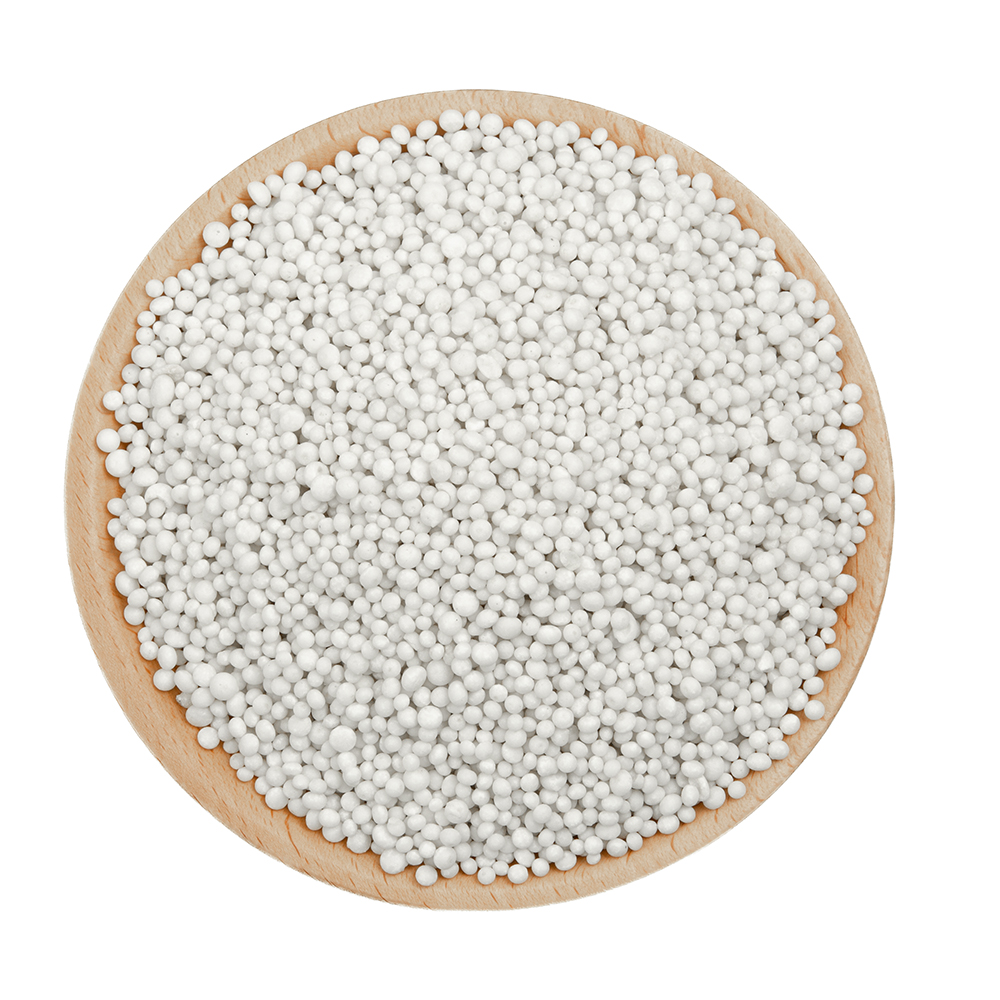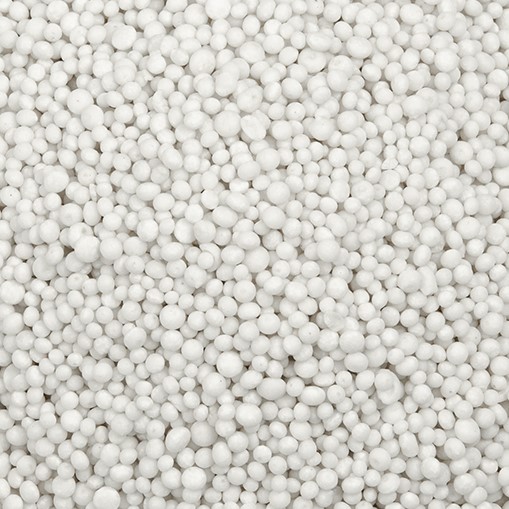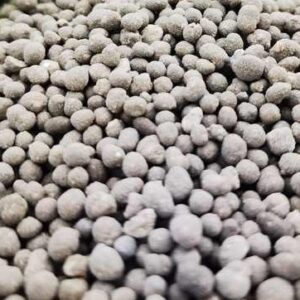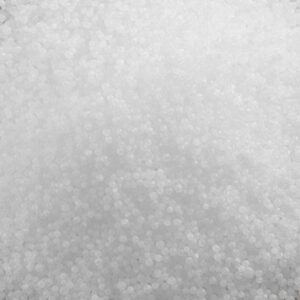Description
Perfectly balanced formula
#1. Macroelements
Nitrogen(N): It stimulates the growth of the vegetative mass, and increases the size and protein content of the grain yield and green mass. Nitrogen is included in proteins. Ammonia nitrogen is not washed out of the soil, in contrast to nitrate nitrogen. It contributes to better phosphorus intake and is absorbed directly by plant roots.
Phosphorus(P): Phosphorus is used in photosynthesis, energy conversion, cell division and growth, and the transfer of genetic information. It contributes to strong root system growth and improves water intake by plants. Enhances resistance to disease and drought, accelerates ripening improves grain quality.
Potassium(K): It ensures normal photosynthesis, and intensifies the synthesis and flow of carbohydrates from plant leaves to storage organs. Provides stability for grain, tubers, and root crops even in dry years and increases starchiness and sugar content.
#2. Mesoelements
Sulphur(S): It is required for many metabolic processes. It is included in three essential amino acids, necessary for protein synthesis. It improves phosphorus absorption by high-calcium soils. Regulates redox processes, photosynthesis and plant growth.
Calcium(Ca): It plays a key role in soil fertility, maintaining the structure of cell walls and the integrity of cell membranes. Eliminates excess soil acidity. Increases caking resistance of the crop. Improves the availability of molybdenum, manganese, zinc, and boron.
Magnesium(Mg): It is a key element for the synthesis of chlorophyll in plants, involved in photosynthesis and protein synthesis. Essential for vegetative growth. It is contained in small amounts in most of our complex fertilizers.
#3. Microelements
Zinc(Zn): It is necessary for the functioning of enzyme systems and protein synthesis. It controls the formation of essential growth and development regulators by plants. It contributes to larger phosphorus uptake by the plant. Most effective on sandy chernozems.
Boron(B): It is necessary for plants to develop new cells in growing organs and tissues. Essential for flowering and formation of fruits and seeds. It is especially effective on carbonate soils.
Composition:
| Fertilizer |
N/% |
P2O5/% |
K2O/% |
S/% |
Zn/% |
B/% |
MgO/% |
| NP(S) 16-20(12) |
16 |
20 |
|
12 |
|
|
0.4-0.6 |
| NP(S) 20-20(14) |
20 |
20 |
|
14 |
|
|
0.1-0.3 |
| NP(S) 14-40(7) |
14 |
40 |
|
7 |
|
|
0.1-0.3 |
| NPK(S) 10-26-26(2) |
10 |
26 |
26 |
2 |
|
|
0.3-1.0 |
| NPK(S) 8-20-30(2) |
8 |
20 |
30 |
2 |
|
|
0.3-1.0 |
| NPK(S) 15-15-15(10) |
15 |
15 |
15 |
10 |
|
|
0.3-1.0 |
| NPK(S) 13-19-19(6) |
13 |
19 |
19 |
6 |
|
|
0.3-1.0 |
| NPK 12-32-16 |
13 |
32 |
16 |
1 |
|
|
0.3-1.0 |
| NPK(S) 8-20-30(2)+0.3B* |
8 |
20 |
30 |
2 |
|
0.3 |
0.3-1.0 |
| NPK(S) 8-20-30(2)+1Zn* |
8 |
20 |
30 |
2 |
1 |
|
0.3-1.0 |
| NPK(S) 10-26-26(2)+0.3В* |
10 |
26 |
26 |
2 |
|
0.3 |
0.3-1.0 |
| NPK(S) 10-26-26(2)+1Zn* |
10 |
26 |
26 |
2 |
1 |
|
0.3-1.0 |
| NPK(S) 13-17-17(6)+0.15B+0.6Zn |
13 |
17 |
17 |
6 |
0.6 |
0.15 |
0.2 |
| NPK(S) 14-18-18(6)+0.3B |
14 |
18 |
18 |
6 |
|
0.3 |
0.2 |
| NPK(S) 14-18-18(6)+0.3Zn* |
14 |
18 |
18 |
6 |
0.3 |
|
0.2 |
| NPK(S) 15-15-15(10)+0.3B |
15 |
15 |
15 |
10 |
|
0.3 |
0.3-1.0 |
| NPK(S) 15-15-15(10)+1Zn* |
15 |
15 |
15 |
10 |
1 |
|
0.3-1.0 |
| NP(S) 14-40(7)+1Zn |
14 |
40 |
|
7 |
1 |
|
0.3-1.0 |
| NP(S) 20-20(14)+0.4Zn |
20 |
20 |
|
14 |
0.4 |
|
0.2 |
water solubility, % of total P2O5: 90
citrate solubility, % of total P2O5: 95
Agricultural Use
Compound fertilizer contains multiple nutrients in each individual granule. This differs from a blend of fertilizers mixed together to achieve a desired average nutrient composition. This difference allows compound fertilizer to be spread so that each granule delivers a mixture of nutrients as it dissolves in the soil and eliminates the potential for segregation of nutrient sources during transport or application. When included in compound fertilizers, a uniform distribution of micronutrients throughout the root zone can be achieved. These fertilizers are especially effective for applying an initial nutrient dose before planting. There are certain ratios of nutrients available from a fertilizer dealer for specific soil and crop conditions. This approach offers the advantage of simplicity in making complex fertilizer decisions but does not allow the flexibility to blend fertilizers to meet specific crop requirements. Turf managers and homeowners often find compound fertilizers desirable.
Management Practices
Compound fertilizers are sometimes more expensive than a physical combination or blend of primary nutrient sources since they require additional processing. However, when consideration is made of all the factors involved with nutrient handling and use, compound fertilizers may offer considerable advantages. Nitrogen is the nutrient that most commonly needs to be carefully managed and reapplied during the growing season. It may not be feasible to supply sufficient N in advance of planting to meet the entire demand (using only compound fertilizer) without over-applying some of the other nutrients. It may be advisable to use a compound fertilizer early in the growing season and then later apply only Nfertilizer as needed. Compound fertilizers are usually produced regionally to meet local crop needs. There is a wide range of chemical and physical properties that can be adjusted to meet these needs. For example, a desire to minimize P in urban stormwater runoff has led some communities to restrict the addition of P to compound fertilizers sold for turf and ornamental purposes. Soils of a region that are typically low in a specific nutrient may have this element boosted in the compound fertilizer.


NP(S) 16-20(12)
A complex three-component fertilizer containing nitrogen, phosphorus and sulphur. It is particularly good for soils with high potassium and low labile sulphur content. High sulphur content makes this grade vital for oilseeds – rapeseed, sunflower, and flax, because sulphur promotes oil accumulation in seeds. Optimized sulphur nutrition is also essential for wheat and soybeans because sulphur promotes protein accumulation in grains.
| COMPOSITION |
| N |
16% |
| P2O5 |
20% |
| water solubility, % of total P2O5 |
90 |
| citrate solubility, % of total P2O5 |
95 |
| K2O |
.% |
| S |
12% |
| MgO |
(0.4-0.6)% |
| APPLICATION |
| Period |
Autumn Spring |
| Method |
During sowing |
| Crops |
Soybeans Chickpea Rape seed Flax Grain Sunflower Maize |
| Soils |
All soils |
| ADVANTAGES |
| #1. Ensures high yields on soils with low labile sulphur |
| #2. Increases protein in grains and oil in seeds |
| #3. Starter spring fertilizer for chickpeas, soybeans, rape, sunflower and flax |
| #4. Mixes well with other fertilizers |
NP(S) 20-20(14)
A complex sulphur-containing fertilizer for high potassium soils. This grade is particularly useful for spring applications when crops require larger amounts of sulphur. Its application helps to ensure the active growth of plants, and build immunity and strength. The quality of the final product is also improved, increasing the protein content in grains and the oil content in sunflower seeds and rapeseed. It is a perfect starter fertilizer for maize.
| COMPOSITION |
| N |
20% |
| P2O5 |
20% |
| water solubility, % of total P2O5 |
90 |
| citrate solubility, % of total P2O5 |
95 |
| K2O |
.% |
| S |
14% |
| MgO |
(0.3–1.0)% |
| APPLICATION |
| Period |
Autumn Spring |
| Method |
During sowing |
| Crops |
Grain, Sunflower, Rapeseed, Maize |
| Soils |
All soils |
| ADVANTAGES |
| #1. Strengthens crop immunity to diseases |
| #2. Ensures high quality of grains, seeds and beans |
| #3. Ensures the best intake of nitrogen and phosphorus from fertilizers |
| #4. Accelerates crop growth through boosting the activity of enzyme systems |
NP(S) 14-40(7)
A complex three-component fertilizer containing nitrogen, phosphorus and sulphur. It is particularly good for soils with low labile phosphorus, high potassium and low labile sulphur. A wide nitrogen/phosphorus ratio enables the effective use of this fertilizer during sowing when placed near seeds.
| COMPOSITION |
| N |
14% |
| P2O5 |
40% |
| water solubility, % of total P2O5 |
90 |
| citrate solubility, % of total P2O5 |
95 |
| K2O |
0% |
| S |
7% |
| MgO |
(0.3–1.0)% |
| APPLICATION |
| Period |
Autumn Spring |
| Method |
During sowing |
| Crops |
All crops |
| Soils |
All soils |
| ADVANTAGES |
| #1. Applied on low phosphorus soils, eliminates sulphur deficiency |
| #2. Applied for legumes responding well to sulphur when a moderate dose of nitrogen is required. |
| #3. Increases protein in grains and oil in seeds |
| #4. Improves plant nutrition with phosphorus at low spring temperatures |
NPK(S) 10-26-26(2)
A classic complex fertilizer used in traditional farming systems as the main fertilizer for both clean-cultivated crops with plowing in autumn and winter crops. Its use is especially advantageous in soil zones with a low content of labile phosphorus and potassium, where the responsiveness of cultivated crops to Diammophosca is higher than on fertile soils.
| COMPOSITION |
| N |
10% |
| P2O5 |
26% |
| water solubility, % of total P2O5 |
90 |
| citrate solubility, % of total P2O5 |
95 |
| K2O |
26% |
| S |
2% |
| MgO |
(0.3–1.0)% |
| APPLICATION |
| Period |
Autumn Spring |
| Method |
During sowing |
| Crops |
All crops |
| Soils |
All soils |
| ADVANTAGES |
| #1. Fully covers crops’ need for phosphorus and potassium, provides a starter dose of nitrogen |
| #2. 100% doses perfectly restore soil fertility for a future harvest |
| #3. Most efficient on soils with high mineral nitrogen content |
| #4. Applied for technical (potatoes, sugar beets, sunflowers) and cereal crops (winter wheat and barley) |
NPK(S) 8-20-30(2)
This grade is high in potassium and phosphorus and low in nitrogen, which is good for main applications since autumn. It is particularly valuable for crops that require large amounts of available phosphorus and potassium in the soil. It is highly efficient on soils with low potassium content and fine-textured soils with a leaching water regime.
It is a universal fertilizer, perfect for perennial grasses, sugar beets and potatoes, as well as cereals and legumes on high sulphur soils.
| COMPOSITION |
| N |
8% |
| P2O5 |
20% |
| water solubility, % of total P2O5 |
90 |
| citrate solubility, % of total P2O5 |
95 |
| K2O |
30% |
| S |
2% |
| MgO |
(0.3–1.0)% |
| APPLICATION |
| Period |
Autumn Spring |
| Method |
During sowing |
| Crops |
All crops |
| Soils |
All soils |
| ADVANTAGES |
| #1. Low nitrogen contributes to the development of tubercles on legume roots |
| #2. Perfect nutrient proportions for autumn application for potatoes, sugar beets and other root crops |
| #3. Most efficient when used as the main fertilizer applied before perennial grass sowing |
| #4. Suitable for potatoes and beets, reduces machine passes through a field |
NPK(S) 15-15-15(10)
A complex universal fertilizer for any soils and crops, most effective when applied for tilled and technical crops – before pre-sowing cultivation or during sowing. It is also a perfect starter fertilizer for spring cereals. The sulphur content ensures a high intake of nitrogen and phosphorus by plants, and potassium facilitates faster transport of synthesis products (carbohydrates) to root vegetables and seeds.
| COMPOSITION |
| N |
15% |
| P2O5 |
15% |
| water solubility, % of total P2O5 |
90 |
| citrate solubility, % of total P2O5 |
95 |
| K2O |
15% |
| S |
10% |
| MgO |
(0.3–1.0)% |
| APPLICATION |
| Period |
Autumn Spring |
| Method |
During sowing |
| Crops |
All crops |
| Soils |
All soils |
| ADVANTAGES |
| #1. Consistent results irrespective of soil or crop characteristics |
| #2. High sulphur content increases the efficiency of nitrogen and phosphorus use by plants |
| #3. Contributes to improving the quality characteristics of the crop: increasing the protein content in grain, oil in seeds and the quality of tubers and root crops |
NPK(S) 13-19-19(6)
Most concentrated complex fertilizer for both basic autumn application on the soil after winter harvesting, and spring application as a pre-sowing and starter fertilizer. It provides technical, cereal and tilled crops with all the phosphorus, potassium and sulphur required. The right proportions of nutrients and water-soluble form enable plants to use the nutrients to maximum effect. It requires no additional nitrogen nutrition when applied to sunflowers.
| COMPOSITION |
| N |
13% |
| P2O5 |
19% |
| water solubility, % of total P2O5 |
90 |
| citrate solubility, % of total P2O5 |
95 |
| K2O |
19% |
| S |
6% |
| MgO |
(0.3–1.0)% |
| APPLICATION |
| Period |
Autumn Spring |
| Method |
During sowing |
| Crops |
All crops |
| Soils |
All soils |
| ADVANTAGES |
| #1. Sulphur in a sulphate form ensures the best intake of nitrogen and phosphorus |
| #2. Improves quality indicators of grain and root and tubers |
| #3. Facilitates maximum yields in case of local application |
| #4. Perfect starter fertilizer for sunflowers and potatoes |
NPK 12-32-16
Complex fertilizer containing nitrogen, phosphorus, potassium and, in a small amount, sulfur. It can be used on different types of soils, especially soils with low labile phosphorus and high labile potassium. It is recommended for all crops, especially containing more phosphorus than potassium in the yield (spiked cereals, maize, legumes).
| COMPOSITION |
| N |
12% |
| P2O5 |
32% |
| water solubility, % of total P2O5 |
90 |
| citrate solubility, % of total P2O5 |
95 |
| K2O |
16% |
| S |
1% |
| MgO |
0.3–1.0% |
| APPLICATION |
| Period |
Autumn Spring |
| Method |
During sowing |
| Crops |
All crops |
| Soils |
All soils |
| ADVANTAGES |
| #1. Applied on soils with low labile phosphorus |
| #2. Improves plant nutrition with phosphorus at low spring temperatures |
| #3. Applied for legumes (soybeans, peas, alfalfa) when a moderate dose of nitrogen is required |
| #4. Starter fertilizer in feed systems for maize, sugar beets |
NPK(S) 8-20-30(2)+0.3B*
This grade is exceptionally highly effective on soils with low potassium, light in terms of their aggregate‑size distribution, on soils with a percolative regime and on calcareous soils with a low presence of labile forms of boron. Both main and starter applications are recommended.
| COMPOSITION |
| N |
8% |
| P2O5 |
20% |
| water solubility, % of total P2O5 |
90 |
| citrate solubility, % of total P2O5 |
95 |
| K2O |
30% |
| S |
2% |
| B |
0.3% |
| MgO |
0.3–1.0% |
|
| APPLICATION |
| Period |
Autumn Spring |
| Method |
Before sowing |
| Crops |
Tomato, Soybeans, Sunflower, Potato, Sugar beat, Mustard |
| Soils |
All soils |
|
| ADVANTAGES |
| #1. Low nitrogen content contributes to the development of nodules on the roots of legumes |
| #2. The ratio of the main elements in combination with boron is ideal for the autumn application for root crops, sunflowers, and potatoes |
| #3. Boron in a single granule with NPK allows full root nutrition with the microelement |
| #4. Highly effective when used as the main fertilizer before sowing perennial grasses with legumes element |
NPK(S) 8-20-30(2)+1Zn*
Complex fertilizer is recommended for soils with insufficient exchangeable potassium and highly‑humous and bleached soils. Suitable for main and pre-sowing applications.
| COMPOSITION |
| N |
8% |
| P2O5 |
20% |
| water solubility, of total P2O5 % |
90 |
| citrate solubility, of total P2O5 % |
95 |
| K2O |
30% |
| S |
2% |
| Zn |
1.0% |
| MgO |
|
|
| APPLICATION |
| Period |
Autumn Spring |
| Method |
Before sowing |
| Crops |
Grain, Beet, Flax, Buckwheat, Potato, Clover, Maize |
| Soils |
All soils |
|
| ADVANTAGES |
| #1. Low nitrogen content contributes to the development of nodules on the roots of legumes |
| #2. The ratio of the main elements in combination with zinc is ideal for the autumn application of maize and grain |
| #3. Zinc in a single granule with NPK increases disease resistance, as well as drought and frost resistance of winter cereals |
| #4. Highly efficient if applied as the main fertilizer used before sowing perennial grasses |
NPK(S) 10-26-26(2)+0.3В*
Efficient complex fertilizer for main application for soils with low presence of labile forms of microelements. Especially efficient in irrigated agriculture with a percolative regime.
| COMPOSITION |
| N |
10% |
| P2O5 |
26% |
| water solubility, of total P2O5 % |
90 |
| citrate solubility, of total P2O5 % |
95 |
| K2O |
2% |
| B |
0.3% |
| MgO |
(0.3-1.0)% |
|
| APPLICATION |
| Period |
Autumn |
| Method |
Before sowing |
| Crops |
Sugar Beet, Spring rape seed, Potato, Soybeans, Sunflower, Maize |
| Soils |
All soils |
|
| ADVANTAGES |
| #1. Covers the need of crops for phosphorus and potassium and provides plants with a starting dose of nitrogen |
| #2. Allows to eliminate of the limiting factor for nutrients |
| #3. Highly efficient for autumn application for crops that have a significant need for boron |
| #4. Well suited for soils with a low content of labile phosphorus and potassium |
NPK(S) 10-26-26(2)+1Zn*
Complex multicomponent fertilizer for main and sowing application on soils with low phosphorus and potassium content. Highly efficient on soils with low zinc content, on calcareous soils with neutral and weakly alkaline reactions, as well as when using high doses of phosphorus fertilizers.
| COMPOSITION |
| N |
10% |
| P2O5 |
26% |
| water solubility, of total P2O5 % |
90 |
| citrate solubility, of total P2O5 % |
95 |
| K2O |
26% |
| S |
2% |
| Zn |
1.0% |
| MgO |
(0.3-1.0)% |
|
| APPLICATION |
| Period |
Spring Autumn |
| Method |
Before sowing, During sowing |
| Crops |
Beet, Flax, Maize, Legume grasses, Sunflower, Potato |
| Soils |
All soils |
|
| ADVANTAGES |
| #1. Compensates for the lack of labile phosphorus and potassium and replenishes Zn in soil |
| #2. Provides plants with a starter nitrogen dose |
| #3. Replenishes soil fertility when applying 100% dose |
| #4. Highly efficient as the main fertilizer before sowing grain crops |
NPK(S) 13-17-17(6)+0.15B+0.6Zn
A unique grade that contains three main macroelements, a mesoelement (sulphur) and microelements (boron and zinc). The fertilizer is perfect for growing almost all crops on soils with low labile sulphur, boron and zinc.
It provides balanced local nutrition of plants during presowing application. It is particularly good for the main application on the soil.
| COMPOSITION |
| N |
13% |
| P2O5 |
17% |
| water solubility, of total P2O5 % |
90 |
| citrate solubility, of total P2O5 % |
95 |
| K2O |
17% |
| S |
6% |
| B |
0.15% |
| Zn |
0.6% |
| MgO |
0.20% |
|
| APPLICATION |
| Period |
Spring Autumn |
| Method |
During sowing |
| Crops |
All crops |
| Soils |
All soils |
|
| ADVANTAGES |
| #1. Fuels plant growth and development |
| #2. Contributes to better fruit and seed set |
| #3. Ensures the most balanced nutrition of crops |
NPK(S) 14-18-18(6)+0.3B
A complex fertilizer is suitable for soils with low labile phosphorus, potassium, sulphur and boron. It is perfect for crops with a high need for sulphur and boron, especially oilseeds – sunflower, and rapeseed. It is a vital grade for all cabbage crops responding well to the application of boron fertilizers, as well as for sugar beets and potatoes.
| COMPOSITION |
| N |
14% |
| P2O5 |
18% |
| water solubility, of total P2O5 % |
90 |
| citrate solubility, of total P2O5 % |
95 |
| K2O |
18% |
| S |
6% |
| B |
0.30% |
| MgO |
0.20% |
|
| APPLICATION |
| Period |
Spring Autumn |
| Method |
During sowing |
| Crops |
All crops |
| Soils |
All soils |
|
| ADVANTAGES |
| #1. Simultaneous application of high doses of phosphorus and potassium on the soil |
| #2. Provides high yield and excellent quality vegetable crops |
| #3. Contributes to better fruit and seed set |
NPK(S) 14-18-18(6)+0.3Zn*
Complex highly-concentrated fertilizer with the high zinc content. Increases absorption of phosphorus both from the fertilizer granules and from the soil. Completely eliminates the need for an additional foliar application for vegetation with zinc-containing preparations subject to an optimal application rate. Highly efficient on all cereal crops. Recommended for medium and low nutrient-rich soils. Used at seeding for soils with high nutrient content.
| COMPOSITION |
| N |
14% |
| P2O5 |
18% |
| water solubility, of total P2O5 % |
90 |
| citrate solubility, of total P2O5 % |
95 |
| K2O |
18% |
| S |
6% |
| Zn |
0.30% |
| MgO |
0.20% |
|
| APPLICATION |
| Period |
Autumn, Spring |
| Method |
Broadcasting, During sowing, For tilling |
| Crops |
Corn, Barley, Rice, Spring wheat, Sunflower, Sorghum, Millet |
| Soils |
All soils |
|
| ADVANTAGES |
| #1. Highly efficient for maintaining and increasing soil fertility |
| #2. The simultaneous application of 6 main nutrients in high dosages fully meets the need of plants for zinc |
| #3. Increases drought resistance and overall immunity of plants features a high coefficient of use of moisture from the soil by plants |
NPK(S) 15-15-15(10)+0.3B
All-purpose complex fertilizer is optimal for use as a starter fertilizer for most crops on all types of soils. High sulfur content has a positive effect on the metabolism of plants and on their ability to use macroelements from soil much more efficiently. Boron promotes the full‑fledged pollination of plants and improves the growth and maturation of seeds and fruits.
| COMPOSITION |
| N |
15% |
| P2O5 |
15% |
| water solubility, of total P2O5 % |
90 |
| citrate solubility, of total P2O5 % |
95 |
| K2O |
15% |
| S |
10% |
| B |
0.30% |
| MgO |
(0.3-1.0)% |
|
| APPLICATION |
| Period |
Autumn, Spring |
| Method |
Before sowing, During sowing |
| Crops |
Beet, Flax, Sunflower, Rape seed, Maize |
| Soils |
All soils |
|
| ADVANTAGES |
| #1. High sulfur content increases resistance to adverse environmental factors while increasing the quality and yield of agricultural crops |
| #2. A balanced ratio of main elements gives an excellent impetus to plant development |
| #3. The ratio of main nutrition elements in combination with boron are ideal for starter application for oilseeds and potato |
| #4. Boron in a single granule with NPK provides comprehensive root nutrition with this microelement |
NPK(S) 15-15-15(10)+1Zn*
Complex fertilizer with an optimal ratio of macro-, meso- and microelements. Increased sulfur content provides a significant effect on low-humic, waterlogged and loamy sand soils, as well as when using high doses of nitrogen fertilizers. Zinc helps increase frost resistance and heat resistance of plants and participates in the photosynthesis and respiration of plants. Most efficient with the local application during sowing.
| COMPOSITION |
| N |
15% |
| P2O5 |
15% |
| water solubility, of total P2O5 % |
90 |
| citrate solubility, of total P2O5 % |
95 |
| K2O |
15% |
| S |
10% |
| Zn |
1.00% |
| MgO |
(0.3-1.0)% |
|
| APPLICATION |
| Period |
Autumn, Spring |
| Method |
Before sowing, During sowing |
| Crops |
Grain, Sunflower, Flax, Maize, Potato, Forage crops |
| Soils |
All soils |
|
| ADVANTAGES |
| #1. High sulfur content increases the utilization coefficient of nitrogen and phosphorus from both fertilizer and soil |
| #2. Balanced amounts of main nutrients in combination with zinc are ideal for pre-and postsowing application |
| #3. Zinc increases disease, as well as drought and frost resistance of winter cereals |
| #4. Highly efficient when used as a sowing fertilizer for accelerated seed germination and plant development |
NP(S) 14-40(7)+1Zn
Complex fertilizer for potassium-rich soils, sod‑podzolic, heavy loamy, and gumbo soils. It increases plant immunity and resistance to adverse environmental factors.
| COMPOSITION |
| N |
14% |
| P2O5 |
40% |
| water solubility, of total P2O5 % |
90 |
| citrate solubility, of total P2O5 % |
95 |
| K2O |
0% |
| S |
7% |
| Zn |
1.00% |
| MgO |
(0.3-1.0)% |
|
| APPLICATION |
| Period |
Autumn, Spring |
| Method |
During sowing |
| Crops |
Grain, Sugar beat, Maize, Peas, Feed crops, Soybeans |
| Soils |
All soils |
|
| ADVANTAGES |
| #1. Improves plant nutrition with phosphorus at low spring temperatures |
| #2. Promotes the development of high-quality grain, seeds, and beans |
| #3. The ratio of nitrogen and phosphorus in combination with zinc is ideal for the autumn application for root crops and maize |
| #4. Sulfur and zinc in a single granule together with other main nutrition elements help to achieve high-quality of grains |
NP(S) 20-20(14)+0.4Zn
A complex fertilizer for maize and cereals containing macro-, meso- and microelements in one granule. Containing zinc, the fertilizer is perfect for cultivating technical crops requiring intensive growth and strong immunity. It prevents temporary stress on plants during the transition from grain to root nutrition.
| COMPOSITION |
| N |
20% |
| P2O5 |
20% |
| water solubility, of total P2O5 % |
90 |
| citrate solubility, of total P2O5 % |
95 |
| K2O |
0% |
| S |
14% |
| Zn |
0.40% |
| MgO |
0.20% |
|
| APPLICATION |
| Period |
Autumn, Spring |
| Method |
During sowing |
| Crops |
Maize, Sunflower, Spring rape seed, Grain |
| Soils |
All soils |
|
| ADVANTAGES |
| #1. Accelerates metabolism and guarantees timely ripening |
| #2. Ensures high quality of grains and seeds |
| #3. Energizes plants for intensive growth |
| #4. Strengthens crop resistance to diseases |
Order Now
Please visit the online shop to get more information on stock and price.








